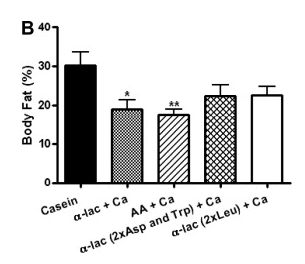Energy Restriction + Whey = Dieting Success, BUT the Magic is not in the Alpha-Lactalbumin
Ever since the first studies showed the beneficial effect of dairy in general and whey in particular on weight loss induced by caloric restriction, scientists have been arguing for alpha-lactalbumin being the key, or at least one of the key factors that contribute to the anti-obesity effects of milk products.
A group of scientists from Finland (Shi. 2011) did now investigate the exact contribution of alpha-lactalbumin to the dairy / whey induced anti-obesity effects. For 50 days Shi et al. fed mice on one out of three isocaloric, energy restricted diets containing either casein (calcium 0.8%) or two different high-calcium (1.8%) whey protein-based (α-lac + Ca and AA + Ca) amino acid mixes, which differed only in the amount of a-lactalbumin they contained. The results contradict the hypothesis that alpha-lactalbumin is the/a major driving force behind dairy induced weight loss outcomes:
Yet, other than the ever-growing leucine fan-group on the web may now be led to believe, a further in-group differentiation (cf. figure 1) into mice receiving additional amino acids (+100% aspartic acid & tryptophan, or +100% leucine) shows that additional leucine does not improve, but in fact blunt fat loss. In this otherwise isocaloric environment, this is probably due to the reduced percentage of other (essential and conditionally essential) amino acids in the chow, the consequences of which may be impaired fatty acid oxidation and suboptimal metabolic function in general.
One last thing, though: Before you completely discard the value of casein or even alpha-lactalbumin in your diet, I better told you that, compared to the amino acid group (without alpha-lactalbumin), all four, the whey + alpha-lactalbumin (all three groups), as well as the casein group retained a higher amount of muscle mass than the amino acid group (cf. figure 2) - with the results for the +100% asp + trp and the +100% leucine being statistically significant.
Bottom line: To cut body fat use pure whey with natural alpha-lactalbumine to optimize fat loss and retain muscle mass. Since, the difference in muscle retention to the other whey + alpha lactalbumine groups is not significant, the addition of supplemental amino acids including the "holy" (you may recognize I cannot stand the way it is currently hyped by the industry) leucine could make sense if you want to gain muscle; according to the data from this study, it is yet superfluous if your intention is to cut body fat.
A group of scientists from Finland (Shi. 2011) did now investigate the exact contribution of alpha-lactalbumin to the dairy / whey induced anti-obesity effects. For 50 days Shi et al. fed mice on one out of three isocaloric, energy restricted diets containing either casein (calcium 0.8%) or two different high-calcium (1.8%) whey protein-based (α-lac + Ca and AA + Ca) amino acid mixes, which differed only in the amount of a-lactalbumin they contained. The results contradict the hypothesis that alpha-lactalbumin is the/a major driving force behind dairy induced weight loss outcomes:
The mice on α-lac and AA lost significantly more weight and body fat than mice on casein diet (P < 0.05). There was no difference between α-lac and AA diets. Ad libitum feeding after weight loss resulted in weight regain and fat accumulation in all groupsSo, in the end, it obviously all comes down to the amino acid composition of whey protein that makes it superior to casein, but not to a similarly composed amino acid mixture without the addition of the alpha-lactalbumin fraction. The fact that none of the tested proteins had an advantage over the other in a non-dieting (i.e. calorically not restricted) environment, also indicates that it is the improved provision of essential amino acids from whey, which makes the difference.
 |
| Figure 1: Body fat percentage of mice after 50 days on different calorically restricted dietary regimens (Shi. 2011) |
One last thing, though: Before you completely discard the value of casein or even alpha-lactalbumin in your diet, I better told you that, compared to the amino acid group (without alpha-lactalbumin), all four, the whey + alpha-lactalbumin (all three groups), as well as the casein group retained a higher amount of muscle mass than the amino acid group (cf. figure 2) - with the results for the +100% asp + trp and the +100% leucine being statistically significant.
Bottom line: To cut body fat use pure whey with natural alpha-lactalbumine to optimize fat loss and retain muscle mass. Since, the difference in muscle retention to the other whey + alpha lactalbumine groups is not significant, the addition of supplemental amino acids including the "holy" (you may recognize I cannot stand the way it is currently hyped by the industry) leucine could make sense if you want to gain muscle; according to the data from this study, it is yet superfluous if your intention is to cut body fat.



